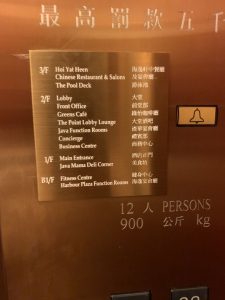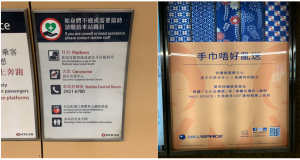Hong Kong, as an international city, has a mixed and interesting linguistic landscape. There are three dominant language in Hong Kong: Cantonese, English and Mandarin I actually put those three languages in order. It might be a little surprising to see there are so many languages in Hong Kong and Mandarin is only ranked in third place. This is because of Hong Kong’s unique history and its role as an international harbor. First, Cantonese is the most widely acknowledged language in Hong Kong and is the first language of most local people. Their TV series, movies and songs are all in Cantonese. Elders in Hong Kong may only understand Cantonese. However, Cantonese doesn’t have its own characters and use Chinese characters in writing (Even though they have some unique words and expressions that are not in Mandarin). Therefore, it’s a lot easier for Chinese to learn Cantonese even though the pronunciations are so different. It’s not surprising to see that English is another official language here because Hong Kong was a British colony before 1997. Most young people in Hong Kong are very fluent in English, even better than Mandarin. In my company, all official communications are written in English. I also write reports and researches in English. Mandarin is less dominant in Hong Kong since most local people started to learn Mandarin after 1997, the return of Hong Kong. Elders cannot speak and understand Mandarins but most students are able to do so. People around 30 and 40 can speak Mandarin, but their accent are very obvious. As I argued above, since Cantonese and Chinese use the same characters, people only know Cantonese can read Chinese.
One interesting picture I took is the sign inside the elevator in my hotel. As you can see, this sign is bilingual in English and traditional Chinese. I noticed that there are two “海逸” in this sign but they are translated differently.( The first and the last line)

At the bottom, “海逸” is translated into “Harbor plaza”, which is also the name of the hotel. In the top, “海逸” is translated by its Cantonese pronunciation “Hoi Yat”. This is interesting to see why they want to translate the same character in different way. I think the difference in translation represents different values behind them. For “Harbor Plaza”, it’s the name of the hotel and it’s easier for English speaker to understand its meaning. This translation is good to be used in the brand cause it’s more straight forward and delivers information to readers. “Hoi Yat” is different. “Hoi Yat Heen” is a Chinese restaurant inside the hotel and also run by the hotel. It wants to emphasize its Chinese and Cantonese side and they decide not to translate “海逸” into “harbor plaza” because it might be strange for a restaurant to be called as a “plaza”. In this way, as they use the Cantonese pronunciation directly, this restaurant clearly shows that it’s a Chinese restaurant in Cantonese style.
Even though Cantonese and traditional Chinese share the same characters, some expression and words differ from each other. There are some unique characters that are not common in Chinese, in deed, appear a lot in written Cantonese.

Those two pictures show some differences between written Cantonese and Chinese. The left one is written in English and traditional Chinese and the second one is written in Cantonese. Both of them contain Chinese characters. However, the right one use some characters in a different way. “唔” means “no” in Cantonese but it sounds like “emmm”, an expression represents hesitation. In Chinese, “不” means “no”. The reason is that “no” sounds like “em” in Cantonese and they just use “唔” to replace “不” in Chinese. The left is more formal and officla because it contains some important information such as AED and phone number of station staffs. It guarantees that Chinese readers won’t be misguided. The right one is an advertisement and the written Cantonese may be friendlier and more kind.